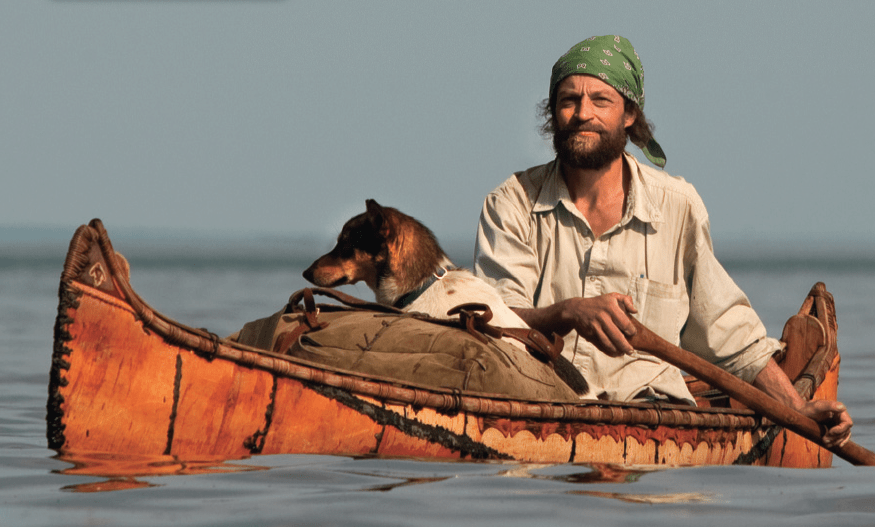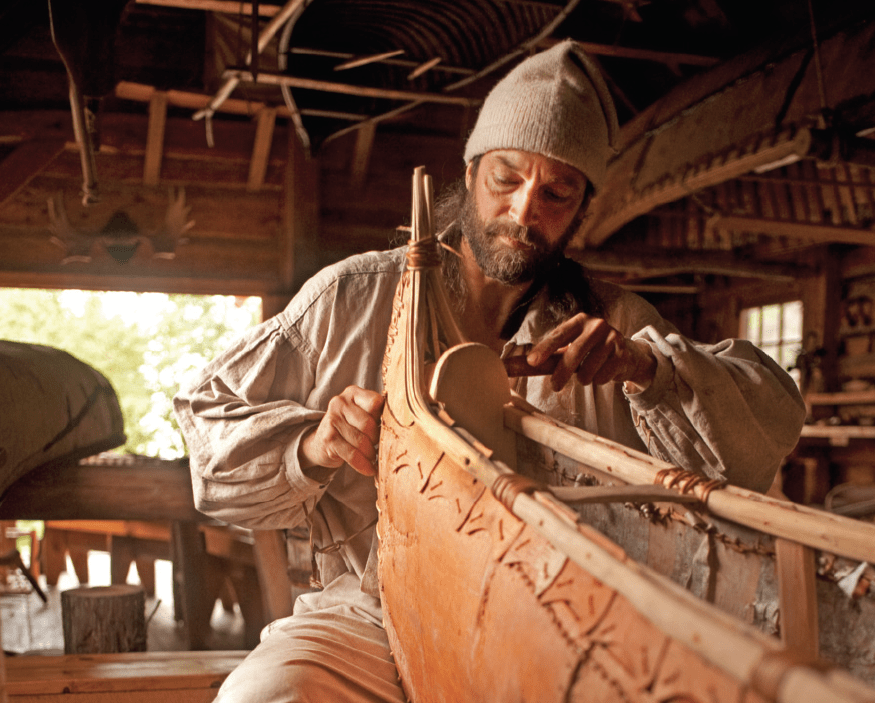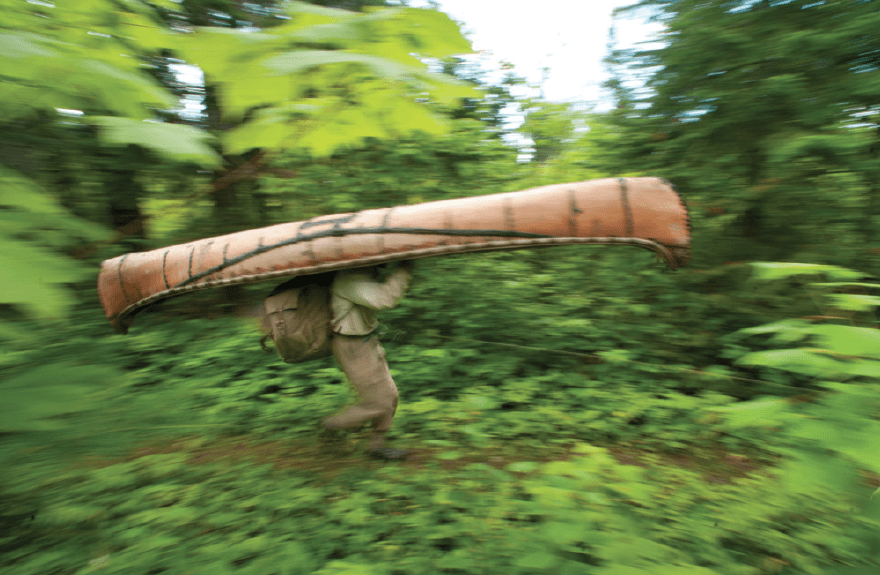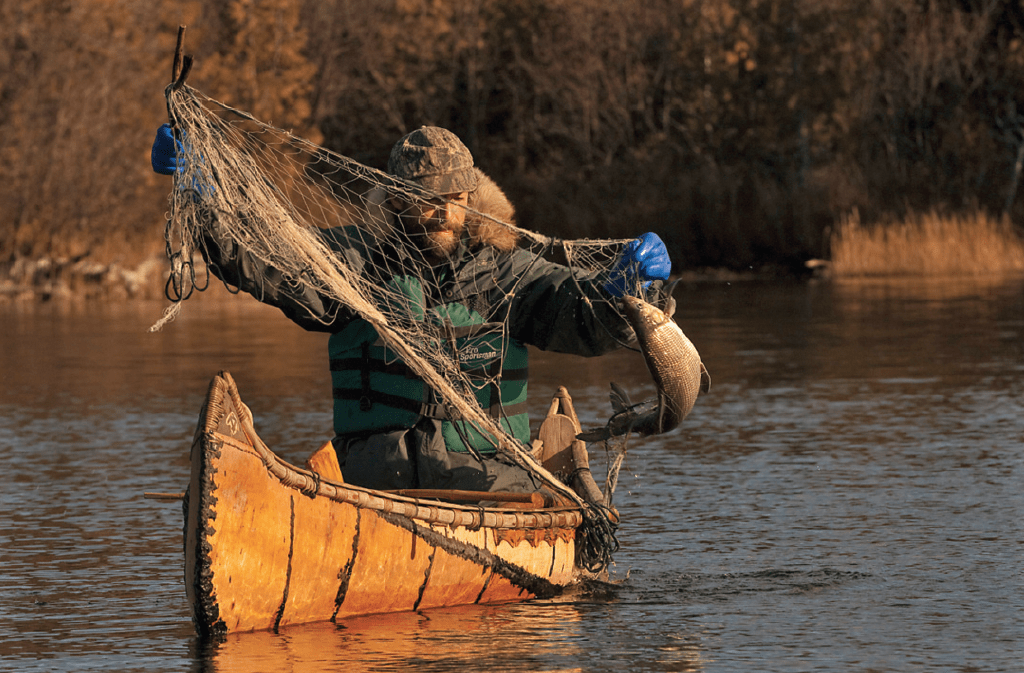
By Alissa Johnson
For twenty years, Erik Simula has lived almost exclusively off the grid near the Minnesota and Canadian border. He hasn’t had a refrigerator or a freezer, and bringing home the groceries has meant using a team of sled dogs to haul them over snow.
“For most of my life, I could never drive to my cabin,” Erik says. He counts moose, red fox, gray jays, and even bears among his neighbors. “I have a pet moose just like anyone that lives way out.”
During the summer, the sled dogs run loose and Erik builds birch bark canoes—he has completed 16 and has four in progress. Come fall he hunts, nets fish, and harvests wild rice. He has slept in teepees, shacks, shanties, and spent more than a few nights under an overturned canoe.
“I have lived, many different times, for long durations isolated from people, and I never really get lonely,” Erik explains. “I’ve always sought to have isolation for the peace and solitude. I’ve never been bored in my life here, nature provides that stimulus for me.”
Yet living in the bush has not meant being a misanthrope. Erik married an Anishinabe woman, and his work has kept him in close contact with people. He has guided sled dog trips for 30 years, and has worked as a wildland fire fighter, a National Park ranger, and a canoe builder at the Grand Portage National Monument. He also teaches at the North House Folk School, where he was the school’s first instructor in residence last summer.
“I’m actually a very quiet person. I really don’t have a lot to just chit chat about, but when there’s something important to talk about I can talk on and on, especially if it’s in my field of knowledge or my job,” he says.
In these roles, Erik can share his intimate knowledge of the woods and traditional crafts like snowshoe making and birch bark canoe building. He demonstrates the connection between folk arts, the land and native cultures—a wisdom he also brings to his work.
The Spirit of the Birch Bark Canoe
“To fully understand and appreciate the birch bark canoe, you have to fully understand the native culture because that’s how it developed. In this region, it’s only been in the last 200 years or less that we developed the canoe using different construction techniques and materials,” Erik says. In his eyes, those newer techniques will never match the resonance and spirit of the birch bark canoe. A birch bark canoe is harvested by hand in the forest. It comes from living trees and materials harvested only after tobacco has been offered and a prayer has been said. The canoe is formed by hand, using stone, bone and steel tools, and keeping good thoughts in mind.
“When you go through all the harvesting and construction of the canoe with that type of approach, something magical happens,” Erik says. “I can sit down and look at a birch bark canoe and get bubbly inside.” But that doesn’t mean they lose their function and become untouchable art. Eric grew up a paddler first and foremost, and he builds his canoes to stand up to whitewater, net fishing, wild rice harvesting and wilderness trips.
In 2009, he paddled a birch bark canoe from Grand Portage to Grand Rapids, Minnesota to attend his daughter’s high school graduation. His return trip took him to International Falls, and through Voyageurs National Park and Quetico Provincial Park. For four months, that birch bark canoe rose to every challenge, and when Erik needed to repair some abrasion from lining rapids, he was able to replace a section of birch bark with natural materials he’d carried with him.
“Few birch bark canoe builders go on and build multiple canoes, but even of those few that do, very few are paddlers,” Erik says. “From an artistic point and from an aesthetic point of view a canoe that is built like that might be a work of art but it’s not functional.”

A Lifetime of Learning
Of course, learning to build a birch bark canoe that can handle a four-month trip doesn’t happen overnight. The learning curve is steep, and it took Erik five years to learn the whole process. He traveled to museums and old resorts, taking pictures and sketching canoes. He visited native elders and other canoe builders, learning something from each one. As he built, he frequently had to repeat steps, learning by doing until he got it right. “It took another five canoes to understand what I was doing,” he says. “It’s a lot more complicated than a lot of people realize. Over the years of teaching, a lot of students come thinking they can dabble and build a birch bark canoe. After a week of study, they realize there’s a lot more to it than they thought.”
The roughly one canoe per year that Erik builds is much slower than native cultures that traditionally built canoes as a family and finished one in just a few weeks. But Erik uses his canoes during demonstrations for his students and builds them on his own or with his wife. In many ways, his canoes serve a purpose greater than any utility—they serve as a vehicle for imparting knowledge and respect to his students.
“My courses are different in that I bring a lot of students into the field, out in the forest,” Erik says. “I really stress sustainable harvesting and ethics when it comes to the traditional use of forest products like birch bark, spruce root, and cedar wood.”
He weaves in lessons on tribal governments and sovereignty, and respect of other cultures. It’s a fitting role for a man who’s spent his life in the woods, just as it’s a fitting life for a man who grew up listening to stories of his great grandfather in Finland, who was also frequently digging up spruce roots and doing birch bark work.

“Being in a similar climate and making a living out of the forest, working with trees and wood… I think that’s one reason I followed that lifestyle,” he says. “I find it very rewarding to be able to make a living off of canoe building or guiding.” To learn more about Erik and his 2009 journey through the Arrowhead Region, visit arrowheadjourney.wordpress.com.
Start to finish, building the birch bark canoe at the North House Folk School has been a year long process for Erik and will be completed in the spring of 2014. Photos by Kate Watson and courtesy of North House.
This article originally appeared in Wilderness News Fall Winter 2013 >


